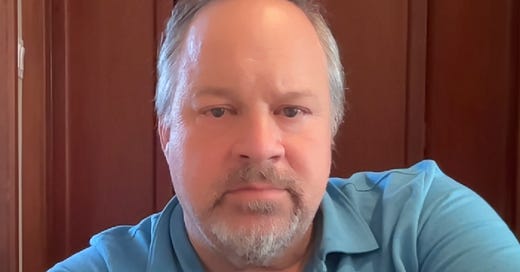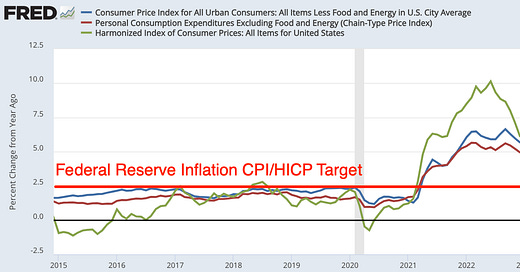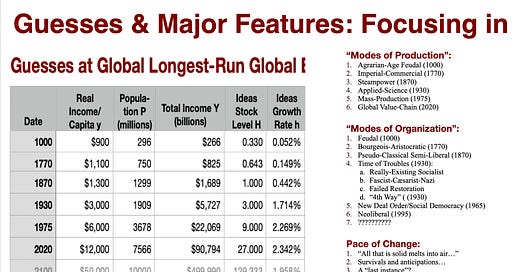
Discover more from Brad DeLong's Grasping Reality
Saturday Night Thoughts on the Need for a Lender of Last Resort
Is Silicon Valley Bank systemically essential? No. Is it systemically important? Yes, in that a failure of the U.S. government to act as a lender of last resort is likely to cause other banks to...
Is Silicon Valley Bank systemically essential? No. Is it systemically important? Yes, in that a failure of the U.S. government to act as a lender-of-last-resort is likely to cause other banks to also hit the wall, and the contagion and disruption will cause losses orders of magnitude larger than the (small, and most likely zero) direct cost to the U.S. taxpayer of acting as a lender-of-last resort here.
Back up: How is it that Silicon Valley Bank [SVB], Thursday the 16th-largest bank in America by assets, is shutdown, in receivership, with every chance of a wild financial ride to come over the next week as every organization with more than $250K in any one bank frantically moves money around to try to get all of its deposits under the $250K FDIC insurance maximum?
As the very sharp Dan Davies writes:
Borrowing short to lend long is what banks are for…. Rules… put reasonable limits on…. The “Net Stable Funding Ratio” [NSFR]… meant to be above 100 per cent… is basically a ratio of the two sides of your balance sheet, after each side is adjusted for liquidity risk…. Short-term Treasury bills get 100-per-cent weightings, while longer-dated corporate bonds get 50-per-cent weightings and loans get zero. Liabilities get weightings according to the likelihood that someone will want cash back immediately. So overnight repo is weighted at 100 per cent and retail deposits are 90 per cent. “Hot money” wealth management and corporate deposits only get a 50-per-cent weighting, and long-term bonds/deposits are zero. If the ratio of the first number to the second is above 100%, then broadly speaking, your long term and illiquid assets are matched by an equivalent amount of long-term and stable liabilities. All of this sounds pretty sensible. So why didn’t this regulation prevent SVB from . . .
And the answer is:
“As a banking organization, our liquidity is subject to supervision by our banking regulators. Because we are a Category IV firm with less than $250 billion in average total consolidated assets, less than $50 billion in average weighted short-term wholesale funding and less than $75 billion in cross-jurisdictional activity, we currently are not subject to the Federal Reserve's LCR or NSFR requirements, either on a full or reduced basis…”
What Dan does not mention is §401 of the 2018 Economic Growth, Regulatory Relief, and Consumer Protection Act:
§165 of the Financial Stabiity Act of 2010… is amended… in the matter preceding paragragph (A), by striking “$50,000,000,000” and inserting “$250,000,000,000”…
supported by 50 Republican and 17 Democratic Senators (and by 225 Republican and 33 Democratic House members), and signed into law by President Trump.
If not for this action of “regulatory relief”, SVB would have been subject to the original Dodd-Frank NSFR, and would have been unable to have taken on the asset portfolio it took on, and so it would not have crashed—at least, not the way it did, and not now.
As Dan Davies says:
Oh….
The fact that a risk isn’t covered by a regulatory ratio doesn’t mean it doesn’t exist…. The fact that large domestic banks in the US are apparently allowed to run such sizable funding mismatches (and indeed, to hang around with massive unrealised losses on hold-to-maturity securities portfolios, which is perhaps a regulatory bedtime story for another day) is likely to be a source of embarrassment to the US authorities…
Even so, SVB knew it had gotten itself into trouble—that it had put too large a share of its assets into long-term Treasuries that it intended to hold-to-maturity, and that while it was notionally hedged against interest-rate duration risk by this hold-to-maturity strategy, that strategy put those assets outside the circle of those available to meet unexpected withdrawals, and so caused liquidity problems. SVB was, I am told by sources who really should know, because they talked to people talking to people doing the deal, that SVB came within twenty minutes of getting enough additional cash to fix likely problems.
Then chaos monkey Peter Thiel showed up: advising companies to pull their money out of SVB.
Since Dodd-Frank, the FDIC-insured limit on commercial bank deposits is $250K—the bank pays insurance premiums into the FDIC so that, if the bank fails, the FDIC makes depositors whole up to a total of $250K each. But SVB’s customers were, predominantly, when weighted by deposits, Silicon-Vally and biotech companies that kept much more than $250K in cash in the bank. The typical customer had $3.5M. Think of a startup with a one-year remaining on its runway—with no sales, trying to make a product, with a headcount of 15 programmers, each of them, with support staff and other costs included, burning $233,000 a year—and, for convenience’ sake, keeping the cash for its next year’s payroll and other expenses in SVB. Thus the overwhelming bulk of SVB’s deposits were uninsured.
In a situation without deposit insurance, a bank run does not require any rational external cause. Its possibility is always baked into the situation. All that has to happen is for a significant number of depositors to become concerned that a significant number of depositors may fear that a critical mass of depositors may withdraw their funds, whether out of fear that the bank is in some sense insolvent, or out of a fear that the bank is illiquid and that its need to suddenly raise cash for payouts to fleeing depositors may depress the prices it can realize for its assets enough to make it insolvent, or simply out of fear that although the bank is and will remain solvent a bank run will create chaos and delay, and so lock-up their funds for a period of time.
Matt Levine sees the Thiel-triggered run on SVB as simply herd behavior. In one of his patented “I was supposed to be off today, but just when I try to get out they drag me back in” pieces, he writes:
As of the end of 2022, Silicon Valley Bank, the actual Bank of Startups, had about $74 billion of loans and about $120 billion of investment securities…. As [Robert] Armstrong puts it, SVB had “a double sensitivity to higher interest rates. On the asset side of the balance sheet, higher rates decrease the value of those long-term debt securities. On the liability side, higher rates mean less money shoved at tech, and as such, a lower supply of cheap deposit funding.”
Also, I am sorry to be rude, but there is another reason that it is maybe not great to be the Bank of Startups, which is that nobody on Earth is more of a herd animal than Silicon Valley venture capitalists…. All of your depositors are startups with the same handful of venture capitalists on their boards, and all those venture capitalists are competing with each other to Add Value and Be Influencers and Do The Current Thing…. [So] all of your depositors will take their money out at the same time. In fact, Bloomberg reported yesterday…. “Prominent venture capitalists including Peter Thiel’s Founders Fund [are]… advis[ing] startups to withdraw their mone …
But, as Noah Smith correctly points out, there was more: SVB did not need its asset sales to raise cash to exert price pressure against it. SVB’s core problem was that its Treasury bonds had lost mark-to-market value. In SVB’s accounting for its hold-to-maturity portfolio, the loss created by the fact that the bonds it held had fallen in price was balanced by an expected capital-gain offset that was going to accrue on the bonds when they were held to maturity. But that only works if the game of musical chairs continues: if the music stops and the bank is liquidated right now, that offsetting expected capital gain vanishes.
And so it did.
If we lived in a good world—one in which Dodd-Frank had, as it should have, established the principle that all commercial banking deposits are insured (and that banks pay insurance premiums on all of their deposits) and if the 2018 EGRR&CPA had not been passed exempting SVB from NSFR, et cetera, then Peter Thiel’s chaos-monkey appearance would not have made a difference. No one would have an incentive to pull their money out of SVB. If anyone had felt the urge, SVB would have had a very different portfolio—one without this mark-to-market loss and the expected-future-capital-gain offset—because it would have had to maintain its NSFR ratio above 100% throughout.
Now the right long-run thing to do is to have a system in which (a) commercial-bank deposits are insured—all of them—and (b) commercial banks are regulated so that they must meet their liquidity and stable-funding ratios.
What is the right shot-run thing to do, now that we are here where we are?
Immanuel Kant would say that the right short-run thing to do is what we would do if we had the right laws for the long run: we should act as if all commercial-banking deposits are insured. In practicem that means (a) finding another bank to take over SVB’s assets and liabilities tomorrow, Sunday; and (b) declare a Systemic Risk Exception so that public money can be committed and earmarked as a reinsurance policy in case it turns out that the problems with SVB run much deeper than it now appears, and whatever bank takes over SVB’s assets and liabilities finds out, afterwards that even when held-to-maturity the assets do not match the liabilities. (I put the odds that that reinsurance policy will be drawn on as low: 10% tops. But the reinsurance policy is needed because there is no time for any taking-over bank to do even a minimum of due diligence.)
What is likely to happen if there is no declaration of Systemic Risk Exception, and no takeover?
Then, Monday, depositors will be made whole up to $250K. Then, probably Tuesday, depositors with holdings in excess of $250K will get about half of that excess back. Then, perhaps Wednesday, the remaining deposits will be transformed into certificates identifying the former depositors as creditors of the in-receivership entity that is SVB, and they will get their money, probably all of their money (my guess is a 90% chance), in due time.
And, Monday, every single entity in the country with more than $250K in any one bank will start frantically moving money around to get all of its cash into accounts with less than the $250K FDIC-insured limit. Lots of banks will have to sell lots of assets in order to payout fleeing depositors. Lots of other banks will see inflows of deposits—J.P. Morgan-Chase, as the strongest bank in the country, especially.
JPMC is almost certain to have to ask for an immediate waiver of the supplementary leverage ratio it needs to meet, or it will have to turn away deposits—tell people who want to put their money in JPMC that the government will not let it accept any more deposits.
Some banks will be especially stress-tested: First Republic, PacWest, Signature, and Western Alliance, —especially, in my view, First Republic—may well turn out to be in situations analogous to that of SVB. I expect them all to skate through if depositors of SVB are made whole. I expect at least one of the four to also find itself in receivership in a week if SVB’s depositors are not whole as of Monday morning.
And then?
The chatter before the uncontrolled bankruptcy of Lehman Brothers in the fall of 2008 was that the Fed and the Treasury should not act as a lender-of-last-resort in this case, that they had made a mistake in letting the creditors of Bear Stearns emerge with whole skins in the spring of 2008, that the market needed to be taught a sharp lesson that becoming a creditor of a badly managed financial institution might cost you money, and that the financial system as such that the downsides from letting that lesson to be taught were unlikely to be large.
That chatter was wrong. The downside was very large indeed.
This time the downside from the U.S. government’s not taking on the lender-of-last-resort role is orders of magnitude smaller.
But the downside is still there.
And even if the direct costs of acting as a lender-of-last-resort in this case turn out to be non-zero, the benefits of avoiding the costs to the real economy imposed by the financial and business disruptions that will flow from a workout that has SVB depositors suffering losses and contagion likely causing further disruptions as other banks now-solvent on a hold-to-maturity basis hit the wall.

















Yes: shareholders are zeroed out. Bonds issued by SVB now trading at 31%
Peter Thiel and his buddy Elon Muck need to be strung up. Together.